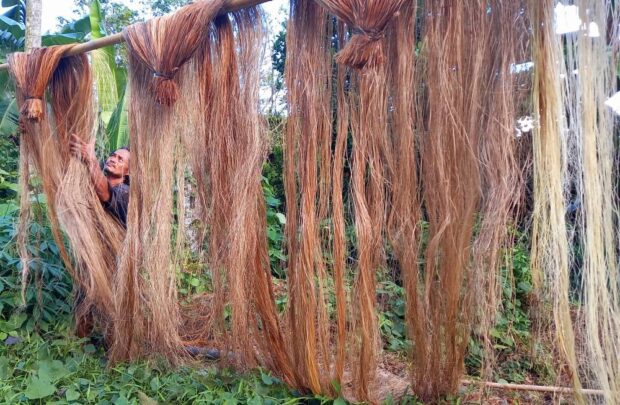Catanduanes abaca farmers face hard times

AIR-DRY Strips of abaca fiber are air-dried by a farmer in Baras, Catanduanes, in this photo taken on Oct. 24, 2022, before these are sold. —MICHAEL B. JAUCIAN
Abaca farmers in Catanduanes, the province dubbed the abaca capital of the Philippines, clamored for more market and funding support as the onslaught of strong typhoons gnaw on the industry and their livelihood, according to the Department of Agriculture’s (DA) regional field office in the Bicol region.
Alejo Tayamora, an abaca farmer in Bato town cultivating Abuad, classified by the DA as the best abaca variety, deplored the low buying price of abaca fiber.
He, along with his hired abaca stripper, could strip five to 10 kilograms of dried abaca a day, which were sold for P40 a kilo to a local trader, or just half of last year’s buying price.
“We should also be given equipment that we can bring to the farm,” Tayamora said in Tagalog in an interview on Friday, referring to a portable spindle machine designed to strip abaca faster.
Dropping prices
Antonio Jimenez Jr., general manager of the Pinoy Lingap Damayan Cooperative located in Virac town, hoped the buying price of dried hand-stripped abaca fiber would return to the level of P85 to P95 per kg.
Article continues after this advertisementJimenez on Friday said abaca producers were incurring “huge losses” due to the wide buying price gap of at least P15 to P18 per kg.
Article continues after this advertisementThe average buying price of grading and baling establishments for abaca fiber declined in 2023, according to data provided by the Philippine Fiber Industry Development Authority (Philfida) to the Inquirer.
For instance, the buying price for abaca fiber grade S2 declined by 4.9 percent to P83.78 per kg (hand-stripped) as of August 2023, from P87.84 per kg in the same period a year ago, while the spindle-stripped abaca fiber grade S2 went down from P89.14 per kg to P88.99 per kg.
Hand-stripped abaca fiber grade JK also declined by 26.6 percent from P63.21 per kg to P49.94 per kg year-on-year; the spindle-stripped slumped by 56.2 percent to P42.27 per kg from P66.04 per kg; the hand-stripped abaca fiber grade I dropped by 9.4 percent to P74.74 per kg from P81.77 per kg; and the spindle-stripped ones fell by 2.5 percent to P79.17 per kg from P81.13 per kg.
No bulk buyers
Elsie Cabrera, one of the licensed processors of Philfida, cited the absence of consolidators or bulk buyers of handicrafts even though the province has many trained weavers.
She said there was no doubt the abaca industry in the province would flourish if the provincial government could help them find bulk buyers.
A group of women was weaving these dried fibers into artful handicrafts such as bags, Filipiniana, plant holders and house decors, according to Cabrera, an accredited trainer of the Technical Education and Skills Development Authority.
Cabrera said they were purchasing dried abaca fibers from the towns of Gigmoto, Baras, San Miguel, Viga and Virac. In January alone, they bought 6,500 kg of different abaca fiber grades at different prices ranging from P40 to P80 per kg.
Anita Tasara, chair of the Provincial Agricultural and Fishery Council, appealed to the government to increase its support for abaca farming as they have no market for trading abaca.
Capital infusion
Associations like the Mabato Integrated Farmers of San Miguel make abaca fiber bags but lacked the capital to market their products, Tasara said.
Catanduanes has 36,853 hectares of land dedicated to abaca production, cultivated by 15,000 farmers.
READ: Diseases, low buying prices continue to dampen abaca production
Philfida earlier said abaca production decreased by 21.6 percent to 37,600.74 metric tons (MT) from January to September 2023 from 47,955.30 MT over the same period in 2022. It attributed the industry’s low performance to a combination of factors, such as the occurrence of natural disasters and the shift in demand for high-grade abaca fiber.
Low buying prices also discouraged the younger generation to pursue abaca farming, the agency said.
The DA said there was a huge demand for abaca fibers at the onset of the COVID-19 pandemic as it was used to produce export-quality personal protective equipment and face masks. However, the demand “stopped abruptly” after the pandemic, particularly among European countries. INQ